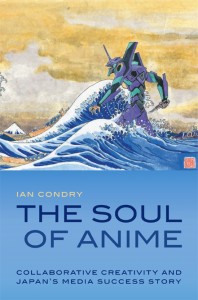JQ Magazine: MIT Professor Ian Condry Explores ‘The Soul of Anime’

“I think it’s a challenge coming back from JET. But the times and experiences we had will really pay off in the long run even if in the short term it’s hard to see how they will apply.” (Courtesy of Web.mit.edu)
By Sheila Burt (Toyama-ken, 2010-12) for JQ magazine. Sheila is a Chicago-based journalist who blogs at www.sheilaburt.com.
Anime can easily be called a global phenomenon. In the past few decades, several anime TV series and movies have grown so successful that even people with little knowledge of Japanese culture can probably name at least one anime show or character. But how is something that is so labor intensive, costly and culturally quirky able to transcend oceans and inspire rabid fan bases?
A participant in the JETAA Regional Conference held at Harvard University earlier this month, cultural anthropologist Ian Condry (Miyagi-ken, 1988-89) explores this question in his new book, The Soul of Anime. An associate professor of comparative media studies at MIT since 2002, Condry researches cultural movements that go global, looking at how and why certain local phenomenon spread. The Soul of Anime is his second book, followed by Hip-Hop Japan: Rap and the Paths of Cultural Globalization (2006), about the inner world of Japanese hip-hop.
Although initially interested in the business model of anime, Condry changed the focus of his research after learning, rather surprisingly, that “No one gets rich making anime. And in fact, it’s a terrible business model.” Rather than looking at how anime sustains itself business-wise, Condry looks at the power of anime as a platform where, oftentimes, fans and other forms of “collaborative creativity” are at the heart of anime’s success. In order to illustrate this argument, Condry tells the story of Gundam, an anime series about giant robots that first aired in 1979. It was initially a ratings failure, but after fans created everything from encyclopedias to timelines about the show, it became a cult sensation, eventually becoming the longest-running anime series in Japanese history.
“If you look at media only in terms of the genius of the creators or the kind of business model that it fits into, then you miss the power of fans and the importance of the value they add to the products,” Condry explains. “That’s sort of what the book is about. I think now we’re starting to see that all over the place with Facebook, Wikipedia, and Twitter, all these kind of media platforms where the content is made by the users but then there’s this interaction between the users and the platform producers that make all the difference.”
Beginning his research in 2004 and gaining access inside several anime studios in the summer of 2006, Condry looks at anime within the context of media studies, a perspective not usually considered by other anime authors. Published by Duke University Press, The Soul of Anime could easily be used for discussion in a Japanese culture class, but it could also interest any anime fan looking to learn more about the industry from an academic point of view.
In addition to his teaching responsibilities at MIT and writing projects, Condry also organizes MIT’s Cool Japan research project, which hosts international conferences and cultural events that promote discussion about media and globalization. Though he only spent one year with the JET Program, Condry says his experience in Miyagi helped shape his future career path, even if indirectly. The perspective he gained in Japan continues to influence his academic research and thinking.
“We all experienced how there is no such thing as one kind of Japanese person. When people start saying, ‘Oh, the Japanese this or the Japanese that,’ I feel like us JETs are like, ‘Wait, wait, wait. They’re not all salarymen; they’re not all submissive housewives,’” he says. “I think that was a very useful lesson that made me rethink how pop culture works and how we have to be careful with our stereotypes and generalizations because if they’re not true for the Japanese, they’re probably not true for anybody.”
After leaving JET, Condry worked as a researcher for the Washington, D.C. bureau of the Yomiuri Shimbun. He considered journalism as a career but discovered he had a stronger interest in academia and anthropology. He left his position at the newspaper to attend graduate school at Yale, where he received his Ph.D. in anthropology in 1999. For JETs still deciding on a career path, he suggests taking time to think about what you want to accomplish in the long term.
“It’s hard to get jobs that are really interesting right off the bat. But what I found was that working in an area or field I was interested in made even the more boring job more useful,” he says. “It allowed me to see, for example, if I really wanted to go into journalism or if I wanted to try something else. So that whole thing about following your dream is really true. I would encourage people to think about what that dream might be.”
“I think it’s a challenge coming back,” he continues. “We’re all going to experience anxiety looking back into our own culture after having such an experience. But the times and experiences we had will really pay off in the long run even if in the short term it’s hard to see how they will apply.
“It is an amazing experience that we’ve had and even if people don’t get it, it’s powerful and meaningful.”
Read more about Ian Condry and the Cool Japan research project at MIT’s website. For more JQ magazine book reviews, click here.



Comments are closed.